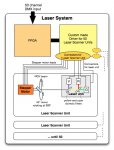Hi everyone,
I am building an art installation for Burning Man with a budget of about $3000. It's gonna be a laser system with 50 RGV lasers all placed in a row. Each laser points to a 45° mirror attached to a stepper motor rotating in the same direction, which makes it a one-axis scanner able to scan a 360° plan (see schema). All the plans will be parallel, spaced by a foot. The installation will be seen from very far away in the desert by night (there is a lot of dust in the air), and I will do animations with the lasers like a wave will the 50 lasers in a row.
I am thinking about using a FPGA (Spartan-3AN) to control the system (from the DMX output of a computer), and build a custom driver that will power the 50 laser scanner units.
I have already started a thread about the RGV part (http://laserpointerforums.com/f40/cheapest-rgv-laser-55606.html) and I want to focus here more on the driver/mechanics.
I am a beginner with laser systems, and am asking gratefully the community for help about the following:
1) What type of stepper motor should I use for this case of one-axis scanner (knowing that 1.8° step is OK for me)? What are the advantages/drawbacks of uni-polar vs bi-polar?
2) Does it seem realistic to use a FPGA to control 50 lasers in angle position and RGV color? That would make about 400 outputs from my driver
3) Is DMX a good idea as input? Any issue with using a FPGA with it?
4) What are the biggest pitfalls I am facing?
Thanks a lot,
I am building an art installation for Burning Man with a budget of about $3000. It's gonna be a laser system with 50 RGV lasers all placed in a row. Each laser points to a 45° mirror attached to a stepper motor rotating in the same direction, which makes it a one-axis scanner able to scan a 360° plan (see schema). All the plans will be parallel, spaced by a foot. The installation will be seen from very far away in the desert by night (there is a lot of dust in the air), and I will do animations with the lasers like a wave will the 50 lasers in a row.
I am thinking about using a FPGA (Spartan-3AN) to control the system (from the DMX output of a computer), and build a custom driver that will power the 50 laser scanner units.
I have already started a thread about the RGV part (http://laserpointerforums.com/f40/cheapest-rgv-laser-55606.html) and I want to focus here more on the driver/mechanics.
I am a beginner with laser systems, and am asking gratefully the community for help about the following:
1) What type of stepper motor should I use for this case of one-axis scanner (knowing that 1.8° step is OK for me)? What are the advantages/drawbacks of uni-polar vs bi-polar?
2) Does it seem realistic to use a FPGA to control 50 lasers in angle position and RGV color? That would make about 400 outputs from my driver
3) Is DMX a good idea as input? Any issue with using a FPGA with it?
4) What are the biggest pitfalls I am facing?
Thanks a lot,
Attachments
Last edited:






